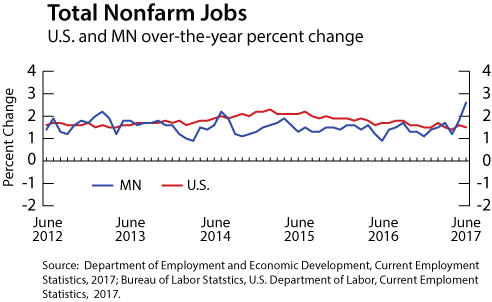by Nick Dobbins
July 2017
Monthly analysis is based on unadjusted employment data.
Employment in the Minneapolis-St. Paul MSA increased by 1.1 percent (22,590) in June, lagging slightly behind the statewide pace. May’s monthly growth was also revised upward, from 1.2 to 1.6 percent. The metro area has now seen greater than 1 percent monthly growth in each of the last three months. While large over-the-month growth is common in April and May, June growth of 1 percent is quite rare, last happening in 2006. The monthly growth was driven in part by larger than usual increase in Leisure and Hospitality employment (up 8,242 or 4.4 percent). On an annual basis the metro area added 64,425 jobs (3.3 percent). This was the highest over-the-year growth rate the area had seen since the late 1990s. Every supersector added jobs on an annual basis, led by Educational and Health Services (up 18,876 or 5.9 percent) and Professional and Business Services (up 12,153 or 3.8 percent). Leisure and Hospitality, which showed a 0.8 percent decline in preliminary May estimates, had that figure revised up to an increase of 1.1 percent in May’s final estimates, then added another 2.7 percent (5,172 jobs) in June’s preliminary estimates. This represents an encouraging change in the supersector, which had previously shown over-the-year job losses in seven consecutive months dating back to October of 2016.
The Duluth-Superior MSA added 1,643 jobs (1.2 percent) in June. The primary growth engines in May were once again driving gains in June, as Leisure and Hospitality added 1,101 jobs (7.8 percent), and Mining, Logging, and Construction added 873 (9.1 percent). Two supersectors lost employment, as Government employers shed 1,043 jobs (3.8 percent) and Trade, Transportation, and Utilities lost 26 (0.1 percent). Annually Duluth added 3,774 jobs (2.8 percent). This represented a big jump from May’s 0.9 percent over-the-year growth. Only one supersector, the perennially struggling Information (down 59 jobs or 4.1 percent), saw negative growth on the year. Growth was led by Mining, Logging, and Construction (up 1,447 jobs or 16 percent) and Educational and Health Services (up 1,102, 3.6 percent). The Financial Activities supersector also had notable growth, adding 245 jobs or 4.2 percent.
Employment in the Rochester MSA was up by 2,423 (2 percent) in June. Both Manufacturing and Leisure and Hospitality had monthly growth of 4.2 percent (440 and 444 jobs, respectively), tying them for the fastest monthly rate in the area. Trade, Transportation, and Utilities, off by 181 jobs (1 percent), was the only supersector to lose jobs. This was the first time the MSA showed over-the-year growth of 2 percent or more since June of 2012. Annually Rochester added 2,325 jobs (1.9 percent), as the over-the-year growth rate continued to tick up. Educational and Health Services, as usual, added the most jobs (up 1,810 or 3.8 percent) while the largest proportional change came in Mining, Logging, and Construction (up 5.6 percent or 273 jobs).
Employment in the St. Cloud MSA was largely flat in June as the MSA added just 52 jobs (0.0 percent). The calm surface hid large changes at the supersector level, however. Government employers lost 703 jobs (4.5 percent), and Educational and Health Services lost 949 (4.2 percent), while a range of supersectors showed counterbalancing gains, including Mining, Logging, and Construction which added 600 jobs (8.2 percent). Annually St. Cloud added 2,840 jobs (2.6 percent). Mining, Logging, and Construction added 863 jobs (12.2 percent), while Educational and Health Services added 1,089 (5.3 percent). Information, Financial Activities and Transportation, Warehousing, and Utilities were the only supersectors to shed jobs on the year.
The Mankato-North Mankato MSA lost 610 jobs (1.1 percent) in June. It was one of only two MSAs in the state (along with Fargo-Moorhead) to lose jobs over the month. Private sector employment was mostly flat, but Government employers lost 671 jobs (6.3 percent). Over the year Mankato added 1,142 jobs (2 percent). Goods producers added 406 jobs (4.1 percent) and service providers added 736 (1.6 percent).
The Fargo-Moorhead MSA lost 472 jobs (0.3 percent) in June. It was one of only two MSAs in the state (along with Mankato) to lose jobs over the month. The decline was largely driven by Government employers, which shed 1,147 jobs (5.9 percent), all from the State and Local levels. Annually Fargo-Moorhead added 3,178 jobs (2.3 percent). Educational and Health Services added 1,139 jobs (5.2 percent), and Manufacturing added 565 (5.9 percent).
The Grand Forks-East Grand Forks MSA added 279 jobs (0.5 percent) in June. Government employers lost jobs, contracting by 212 (1.5 percent), but that loss was more than made up in the private sector, which added 491 jobs (1.2 percent) on the strength of the addition of 288 jobs (8.5 percent) in Mining, Logging, and Constructions. Manufacturing also added 196 jobs (4.7 percent). Annually the area added 180 jobs (0.3 percent). While this represents the slowest over-the-year growth rate of any MSA in the state, it is an improvement over May’s estimates, which showed an annual employment decline. The fastest annual growth in June occurred in Manufacturing, which added 431 jobs (11 percent). The largest decline came in Mining, Logging, and Construction, which lost 989 jobs (21.3 percent).
